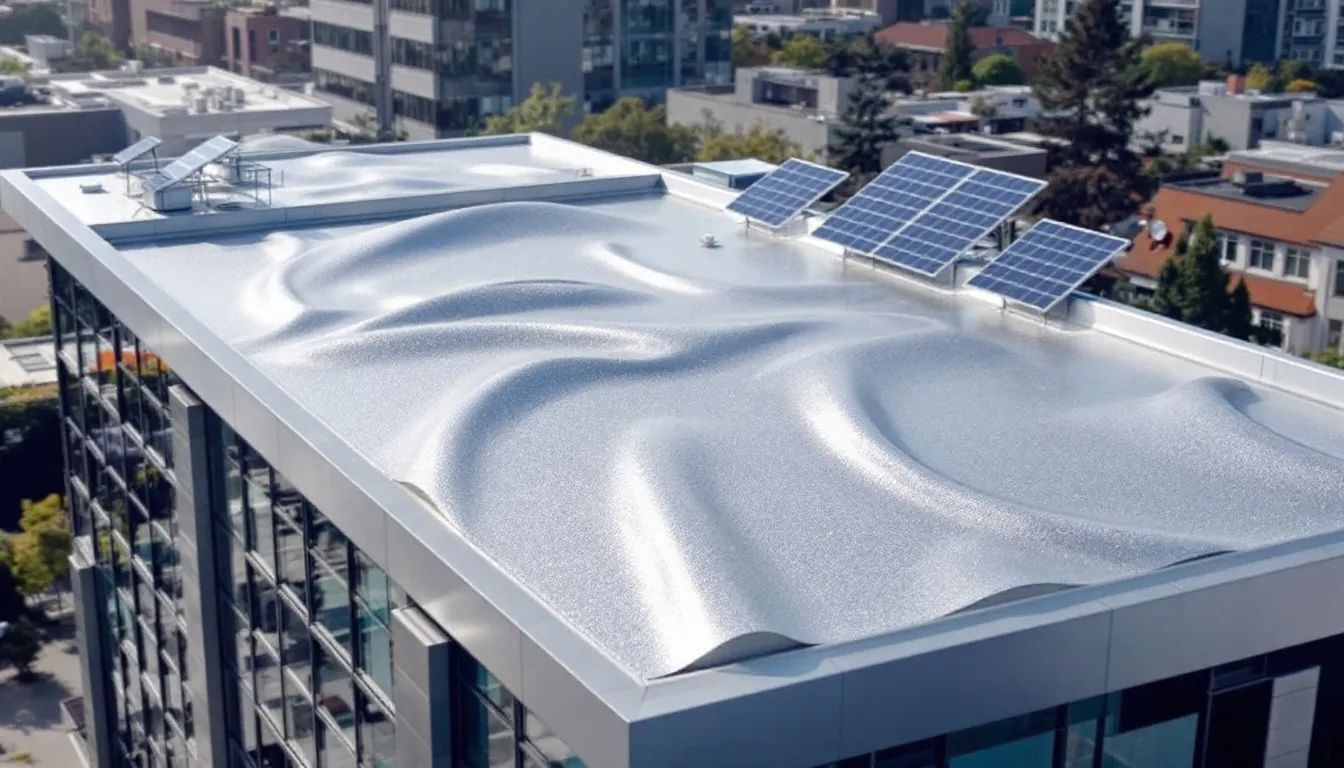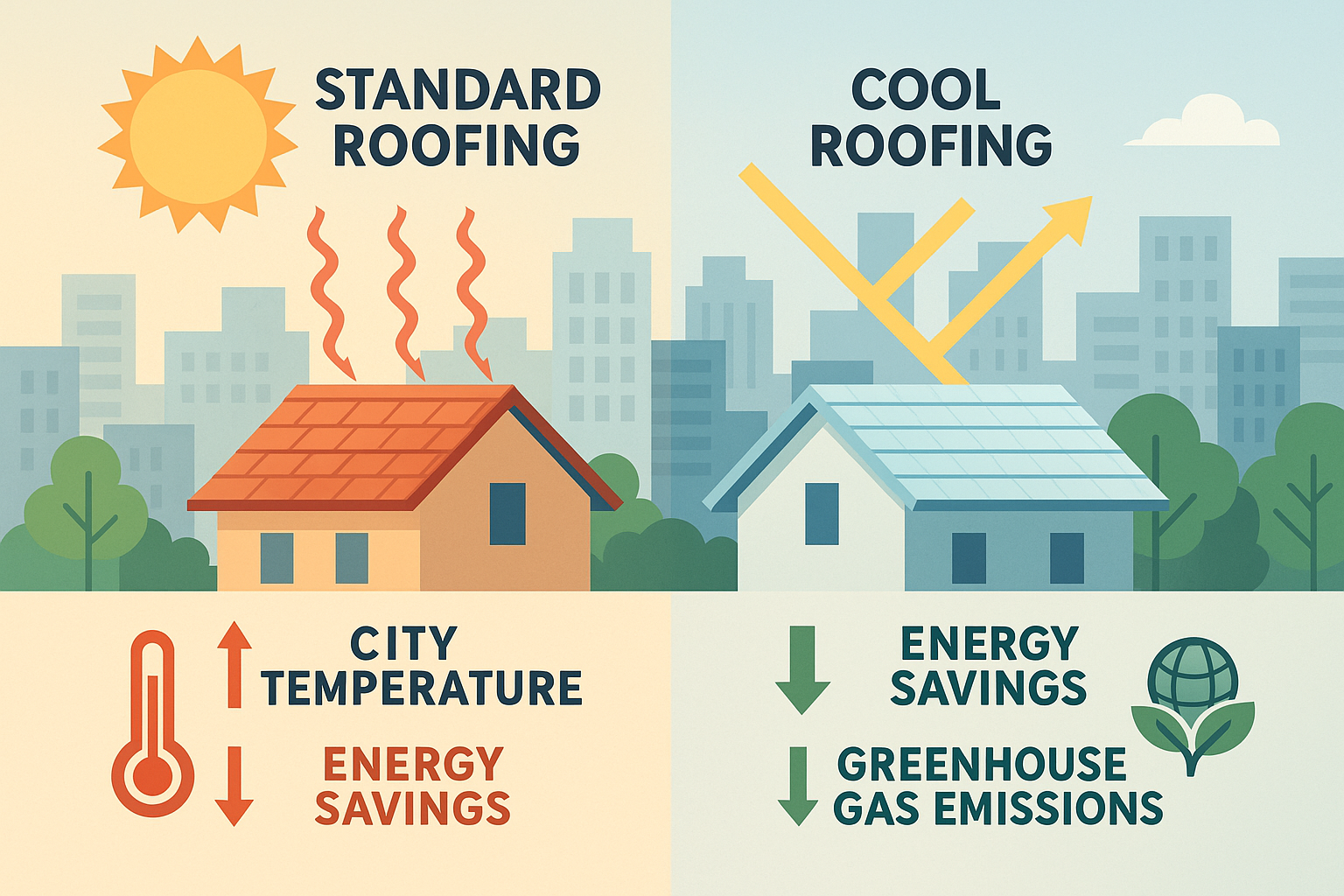
What Are Cool Roofs?
A cool roof is designed to reflect more sunlight and absorb less heat than a conventional roof. These roofs feature high solar reflectance and high thermal emittance, reducing the amount of heat transferred into a building. This leads to lower indoor temperatures, reduced air conditioning use, and increased energy efficiency.
How Cool Roofs Work
Cool roofs function by reflecting solar radiation and emitting absorbed heat back into the atmosphere. Conventional roofs, especially dark-colored ones, can reach temperatures of 150°F (66°C) or more on hot summer days, whereas cool roofs remain significantly cooler, often by 50°F (28°C) or more. As a result, cool roofs help maintain lower temperatures inside buildings during hot months compared to traditional roofing.
Key Characteristics of Cool Roofs
-
High Solar Reflectance – Reflects solar radiation, reducing heat absorption.
-
High Thermal Emittance – Releases absorbed heat efficiently.
-
Reduced Energy Costs – Lowers peak energy demands, reducing energy bills.
-
Increased Indoor Comfort – Keeps indoor spaces cooler with less air conditioning use.
-
Urban Heat Island Mitigation – Helps decrease air temperatures in cities.
Types of Cool Roofing Materials
Cool roofing materials are available for both low-sloped and steep-sloped roofs, making them suitable for residential buildings, commercial buildings, and industrial facilities.
When selecting cool roofing materials, several factors such as climate, insulation, and roof types should be considered to ensure optimal performance and energy efficiency.
Common Cool Roofing Materials
|
Material |
Roof Type |
Features |
|---|---|---|
|
Single-Ply Membranes |
Low-sloped |
Prefabricated sheets with high solar reflectance and thermal emittance. Spray polyurethane foam roofs are created by mixing two liquid chemicals that react to form a solid, seamless layer; these systems often use liquid chemicals for protective, reflective coatings. |
|
Built-Up Roofs (BUR) |
Low-sloped |
Composed of fabric reinforcement layers and cool coatings for durability. |
|
Built Up Roof |
Low-sloped |
Layered construction using alternating plies of bitumen and reinforcing fabrics, often finished with reflective materials or coatings to enhance solar reflectance and protect the surface. |
|
Asphalt Shingles |
Steep-sloped |
Available with reflective mineral granules to reduce heat absorption. |
|
Metal Roofs |
Low & Steep-sloped |
Naturally reflective and can be coated for additional energy efficiency. |
|
Metal Shingles |
Steep-sloped |
Metal roof coverings shaped to imitate other materials, such as asphalt shingles or clay tiles, and available with factory-applied reflective coatings to improve solar reflectance and appearance. |
|
Clay Tiles |
Steep-sloped |
Made from natural clay, including terra cotta (unglazed) and glazed options, offering various colors and high durability. Can be selected or treated for enhanced thermal performance and reflectivity. |
|
Concrete Tile |
Steep-sloped |
Formed from gray-cement concrete, available in a range of colors and finishes. Can be coated or finished with reflective materials to improve cool roof performance and water resistance. |
|
Green Roofs |
Various |
Vegetative covering that reduces ambient temperatures and improves air quality. |
Reflective materials, such as coatings and membranes, are essential for maximizing the solar reflectance of cool roofs. A white surface is especially effective at reflecting solar energy, reducing roof temperatures, and improving energy efficiency.
Energy Efficiency and Cost Savings
How Cool Roofs Save Energy
Buildings with cool roofs use up to 40% less cooling energy compared to those with conventional roofing materials. This results in energy savings of 7%–15% on total air conditioning costs.
-
Lower Peak Energy Demands – Reduces electricity use during hot summer months.
-
Extended Roof Life – Minimizes wear and tear due to less heat exposure.
-
Faster Payback – Cool roofs have a payback period as low as six years due to lower energy costs.
Energy Consumption Reduction
|
Roof Type |
Cooling Energy Use Reduction (%) |
|---|---|
|
Cool Roof (High Reflectance) |
40% |
|
Light-Colored Conventional Roof |
15% |
|
Dark Conventional Roof |
0% |
Environmental Benefits

Cool roofing materials not only reflect more sunlight but also absorb less heat than standard roofing products, leading to lower roof temperatures and reduced energy consumption. This helps decrease greenhouse gas emissions and supports a more sustainable environment. In urban areas, these benefits are especially important, as cool roofing helps reduce temperatures and improve air quality in densely populated city environments.
Reducing Urban Heat Island Effect
The urban heat island effect occurs when cities experience higher temperatures than surrounding rural areas due to heat-absorbing surfaces like asphalt and dark roofs. Cool roofs mitigate this by reducing city-wide temperatures by up to 5.4°F (3°C) during the day and 22°F (12°C) at night.
Additional Environmental Advantages
-
Lower Greenhouse Gas Emissions – Decreases the need for electricity, reducing carbon footprint.
-
Improved Air Quality – Reduces ground-level ozone and smog formation.
-
Decreased Heat-Related Mortality – Helps protect vulnerable populations from heat-related illnesses.
Climate and Environmental Considerations
Cool Roofs in Different Climates
While cool roofing materials work best in hot climates, they may not be ideal for cold climates, where heating penalties can offset cooling benefits.
-
Hot Climates – Maximizes energy savings and indoor comfort.
-
Cold Climates – Potential for moisture accumulation and increased heating costs.
-
Humid Regions – Prone to dark growths, requiring periodic cleaning.
Design and Installation
Cool roofs can be installed on new construction or added to existing buildings during roofing projects. There are various cool roof techniques, such as reflective coatings, single-ply membranes, and spray foam applications, each tailored to different roof types to maximize heat reduction and energy savings. Proper installation ensures longevity and energy efficiency.
Installation Methods
-
Cool Coatings – Applied like paint to improve solar reflectance.
-
Reflective Shingles – Pre-manufactured with high solar reflectance.
-
Metal Roofs – Can be coated for additional thermal emittance.
-
Single-Ply Membranes – Prefabricated sheets that are durable and reflective.
Selecting the Right Cool Roof
Choosing the correct cool roofing material depends on factors like roof slope, climate, and building type. The Cool Roof Rating Council (CRRC) maintains an extensive database of cool roofing products.
Factors to Consider
-
Energy Efficiency Gains – Determine if savings justify initial costs.
-
Roof Type – Consider steep-sloped or low-sloped options.
-
Climate – Assess cooling vs. heating cost balance.
Incentives and Regulations
Government agencies and utility companies offer rebates and tax credits to encourage cool roof installation. Some municipalities require cool roofs for new construction and re-roofing projects.
-
California Title 24 – Mandates cool roof requirements for certain building types.
-
LEED Certification – Credits available for energy-efficient roofing.
-
Local Utility Rebates – Financial incentives for installing cool materials.
For more details, visit the Cool Roof Rating Council at www.coolroofs.org.
Case Studies and Examples
Successful Implementation of Cool Roofs
Chicago’s Cool Roof Initiative
-
Implemented cool roofs on city buildings to lower air conditioning costs.
-
Reduced urban heat island effect by lowering ambient temperatures.
Los Angeles Cool Roof Program
-
Requires cool roofs for new buildings and re-roofing projects.
-
Helps residents save on energy bills while reducing smog.
Maintenance and Performance
How to Maintain a Cool Roof
-
Regular Cleaning – Removes dirt and algae to maintain reflectance.
-
Periodic Inspections – Identifies wear and ensures optimal performance.
-
Re-coating if Necessary – Extends roof lifespan and improves solar reflectance.
Lifespan of Cool Roofs
Depending on the material, cool roofs last between 15 to 40 years with proper care.
Future of Cool Roofs
Advancements in Cool Roofing Technology
-
New Reflective Coatings – Improved formulas for higher solar reflectance.
-
Retroreflective Materials – Enhancing thermal performance.
-
Integration with Green Roofs – Combining vegetation and cool materials for maximum efficiency.
The Future of Energy-Efficient Buildings
As cities adopt urban planning policies to mitigate climate change, cool roofs will play a crucial role in sustainable building strategies.
For further research, visit:
-
U.S. Department of Energy – Cool Roofs

https://shorturl.fm/fGaUW